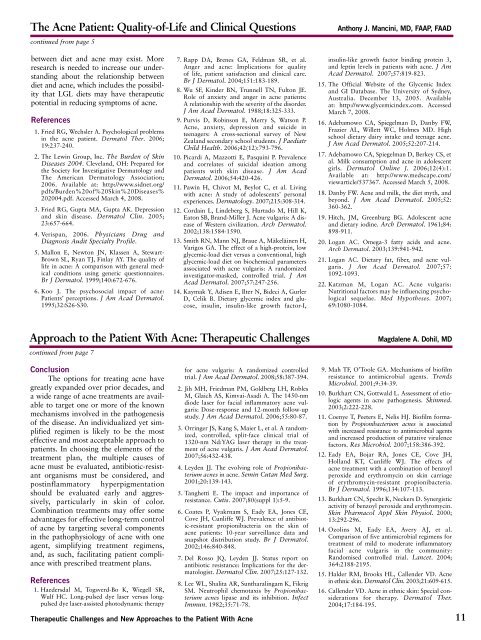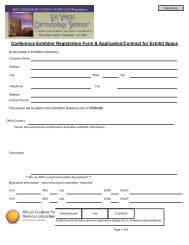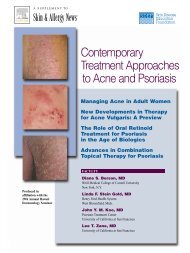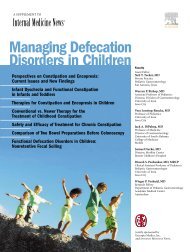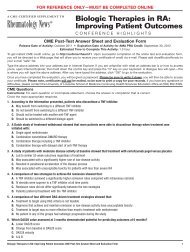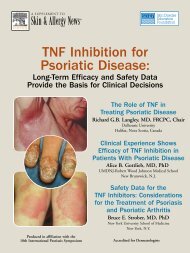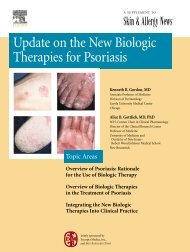Skin & Allergy News® - Global Academy for Medical Education
Skin & Allergy News® - Global Academy for Medical Education
Skin & Allergy News® - Global Academy for Medical Education
You also want an ePaper? Increase the reach of your titles
YUMPU automatically turns print PDFs into web optimized ePapers that Google loves.
The Acne Patient: Quality-of-Life and Clinical Questions<br />
continued from page 5<br />
Anthony J. Mancini, MD, FAAP, FAAD<br />
between diet and acne may exist. More<br />
research is needed to increase our understanding<br />
about the relationship between<br />
diet and acne, which includes the possibility<br />
that LGL diets may have therapeutic<br />
potential in reducing symptoms of acne.<br />
References<br />
1. Fried RG, Wechsler A. Psychological problems<br />
in the acne patient. Dermatol Ther. 2006;<br />
19:237-240.<br />
2. The Lewin Group, Inc. The Burden of <strong>Skin</strong><br />
Diseases 2004. Cleveland, OH: Prepared <strong>for</strong><br />
the Society <strong>for</strong> Investigative Dermatology and<br />
The American Dermatology Association;<br />
2006. Available at: http://www.sidnet.org/<br />
pdfs/Burden%20of%20<strong>Skin</strong>%20Diseases%<br />
202004.pdf. Accessed March 4, 2008.<br />
3. Fried RG, Gupta MA, Gupta AK. Depression<br />
and skin disease. Dermatol Clin. 2005;<br />
23:657-664.<br />
4. Verispan, 2006. Physicians Drug and<br />
Diagnosis Audit Specialty Profile.<br />
5. Mallon E, Newton JN, Klassen A, Stewart-<br />
Brown SL, Ryan TJ, Finlay AY. The quality of<br />
life in acne: A comparison with general medical<br />
conditions using generic questionnaires.<br />
Br J Dermatol. 1999;140:672-676.<br />
6. Koo J. The psychosocial impact of acne:<br />
Patients’ perceptions. J Am Acad Dermatol.<br />
1995;32:S26-S30.<br />
7. Rapp DA, Brenes GA, Feldman SR, et al.<br />
Anger and acne: Implications <strong>for</strong> quality<br />
of life, patient satisfaction and clinical care.<br />
Br J Dermatol. 2004;151:183-189.<br />
8. Wu SF, Kinder BN, Trunnell TN, Fulton JE.<br />
Role of anxiety and anger in acne patients:<br />
A relationship with the severity of the disorder.<br />
J Am Acad Dermatol. 1988;18:325-333.<br />
9. Purvis D, Robinson E, Merry S, Watson P.<br />
Acne, anxiety, depression and suicide in<br />
teenagers: A cross-sectional survey of New<br />
Zealand secondary school students. J Paediatr<br />
Child Health. 2006;42(12):793-796.<br />
10. Picardi A, Mazzotti E, Pasquini P. Prevalence<br />
and correlates of suicidal ideation among<br />
patients with skin disease. J Am Acad<br />
Dermatol. 2006;54:420-426.<br />
11. Pawin H, Chivot M, Beylot C, et al. Living<br />
with acne: A study of adolescents’ personal<br />
experiences. Dermatology. 2007;215:308-314.<br />
12. Cordain L, Lindeberg S, Hurtado M, Hill K,<br />
Eaton SB, Brand-Miller J. Acne vulgaris: A disease<br />
of Western civilization. Arch Dermatol.<br />
2002;138:1584-1590.<br />
13. Smith RN, Mann NJ, Braue A, Mäkeläinen H,<br />
Varigos GA. The effect of a high-protein, low<br />
glycemic-load diet versus a conventional, high<br />
glycemic-load diet on biochemical parameters<br />
associated with acne vulgaris: A randomized<br />
investigator-masked, controlled trial. J Am<br />
Acad Dermatol. 2007;57:247-256.<br />
14. Kaymak Y, Adisen E, Ilter N, Bideci A, Gurler<br />
D, Celik B. Dietary glycemic index and glucose,<br />
insulin, insulin-like growth factor-I,<br />
insulin-like growth factor binding protein 3,<br />
and leptin levels in patients with acne. J Am<br />
Acad Dermatol. 2007;57:819-823.<br />
15. The Official Website of the Glycemic Index<br />
and GI Database. The University of Sydney,<br />
Australia. December 13, 2005. Available<br />
at: http://www.glycemicindex.com. Accessed<br />
March 7, 2008.<br />
16. Adebamowo CA, Spiegelman D, Danby FW,<br />
Frazier AL, Willett WC, Holmes MD. High<br />
school dietary dairy intake and teenage acne.<br />
J Am Acad Dermatol. 2005;52:207-214.<br />
17. Adebamowo CA, Spiegelman D, Berkey CS, et<br />
al. Milk consumption and acne in adolescent<br />
girls. Dermatol Online J. 2006;12(4):1.<br />
Available at: http://www.medscape.com/<br />
viewarticle/537367. Accessed March 5, 2008.<br />
18. Danby FW. Acne and milk, the diet myth, and<br />
beyond. J Am Acad Dermatol. 2005;52:<br />
360-362.<br />
19. Hitch, JM, Greenburg BG. Adolescent acne<br />
and dietary iodine. Arch Dermatol. 1961;84:<br />
898-911.<br />
20. Logan AC. Omega-3 fatty acids and acne.<br />
Arch Dermatol. 2003;139:941-942.<br />
21. Logan AC. Dietary fat, fiber, and acne vulgaris.<br />
J Am Acad Dermatol. 2007;57:<br />
1092-1093.<br />
22. Katzman M, Logan AC. Acne vulgaris:<br />
Nutritional factors may be influencing psychological<br />
sequelae. Med Hypotheses. 2007;<br />
69:1080-1084.<br />
Approach to the Patient With Acne: Therapeutic Challenges<br />
continued from page 7<br />
Magdalene A. Dohil, MD<br />
Conclusion<br />
The options <strong>for</strong> treating acne have<br />
greatly expanded over prior decades, and<br />
a wide range of acne treatments are available<br />
to target one or more of the known<br />
mechanisms involved in the pathogenesis<br />
of the disease. An individualized yet simplified<br />
regimen is likely to be the most<br />
effective and most acceptable approach to<br />
patients. In choosing the elements of the<br />
treatment plan, the multiple causes of<br />
acne must be evaluated, antibiotic-resistant<br />
organisms must be considered, and<br />
postinflammatory hyperpigmentation<br />
should be evaluated early and aggressively,<br />
particularly in skin of color.<br />
Combination treatments may offer some<br />
advantages <strong>for</strong> effective long-term control<br />
of acne by targeting several components<br />
in the pathophysiology of acne with one<br />
agent, simplifying treatment regimens,<br />
and, as such, facilitating patient compliance<br />
with prescribed treatment plans.<br />
References<br />
1. Haedersdal M, Togsverd-Bo K, Wiegell SR,<br />
Wulf HC. Long-pulsed dye laser versus longpulsed<br />
dye laser-assisted photodynamic therapy<br />
<strong>for</strong> acne vulgaris: A randomized controlled<br />
trial. J Am Acad Dermatol. 2008;58:387-394.<br />
2. Jih MH, Friedman PM, Goldberg LH, Robles<br />
M, Glaich AS, Kimvai-Asadi A. The 1450-nm<br />
diode laser <strong>for</strong> facial inflammatory acne vulgaris:<br />
Dose-response and 12-month follow-up<br />
study. J Am Acad Dermatol. 2006;55:80-87.<br />
3. Orringer JS, Kang S, Maier L, et al. A randomized,<br />
controlled, split-face clinical trial of<br />
1320-nm Nd:YAG laser therapy in the treatment<br />
of acne vulgaris. J Am Acad Dermatol.<br />
2007;56:432-438.<br />
4. Leyden JJ. The evolving role of Propionibacterium<br />
acnes in acne. Semin Cutan Med Surg.<br />
2001;20:139-143.<br />
5. Tanghetti E. The impact and importance of<br />
resistance. Cutis. 2007;80(suppl 1):5-9.<br />
6. Coates P, Vyakrnam S, Eady EA, Jones CE,<br />
Cove JH, Cunliffe WJ. Prevalence of antibiotic-resistant<br />
propionibacteria on the skin of<br />
acne patients: 10-year surveillance data and<br />
snapshot distribution study. Br J Dermatol.<br />
2002;146:840-848.<br />
7. Del Rosso JQ, Leyden JJ. Status report on<br />
antibiotic resistance: Implications <strong>for</strong> the dermatologist.<br />
Dermatol Clin. 2007;25:127-132.<br />
8. Lee WL, Shalita AR, Suntharalingam K, Fikrig<br />
SM. Neutrophil chemotaxis by Propionibacterium<br />
acnes lipase and its inhibition. Infect<br />
Immun. 1982;35:71-78.<br />
9. Mah TF, O’Toole GA. Mechanisms of biofilm<br />
resistance to antimicrobial agents. Trends<br />
Microbiol. 2001;9:34-39.<br />
10. Burkhart CN, Gottwald L. Assessment of etiologic<br />
agents in acne pathogenesis. <strong>Skin</strong>med.<br />
2003;2:222-228.<br />
11. Coenye T, Peeters E, Nelis HJ. Biofilm <strong>for</strong>mation<br />
by Propionibacterium acnes is associated<br />
with increased resistance to antimicrobial agents<br />
and increased production of putative virulence<br />
factors. Res Microbiol. 2007;158:386-392.<br />
12. Eady EA, Bojar RA, Jones CE, Cove JH,<br />
Holland KT, Cunliffe WJ. The effects of<br />
acne treatment with a combination of benzoyl<br />
peroxide and erythromycin on skin carriage<br />
of erythromycin-resistant propionibacteria.<br />
Br J Dermatol. 1996;134:107-113.<br />
13. Burkhart CN, Specht K, Neckers D. Synergistic<br />
activity of benzoyl peroxide and erythromycin.<br />
<strong>Skin</strong> Pharmacol Appl <strong>Skin</strong> Physiol. 2000;<br />
13:292-296.<br />
14. Ozolins M, Eady EA, Avery AJ, et al.<br />
Comparison of five antimicrobial regimens <strong>for</strong><br />
treatment of mild to moderate inflammatory<br />
facial acne vulgaris in the community:<br />
Randomised controlled trial. Lancet. 2004;<br />
364:2188-2195.<br />
15. Halder RM, Brooks HL, Callender VD. Acne<br />
in ethnic skin. Dermatol Clin. 2003;21:609-615.<br />
16. Callender VD. Acne in ethnic skin: Special considerations<br />
<strong>for</strong> therapy. Dermatol Ther.<br />
2004;17:184-195.<br />
Therapeutic Challenges and New Approaches to the Patient With Acne 11


